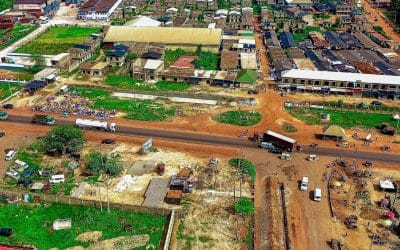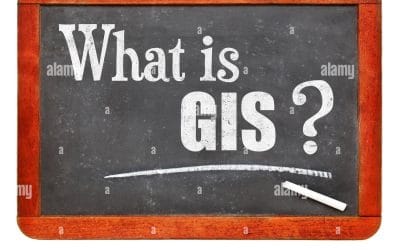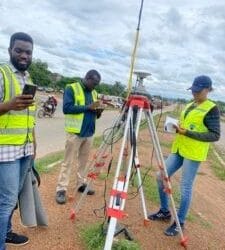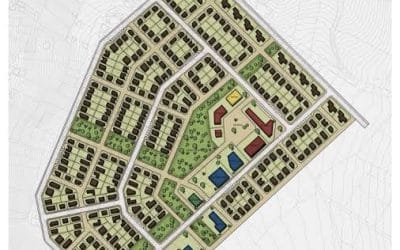Geological Report on a Mining/Exploration Survey
INTRODUCTION
Geo-infotech Resources Limited was granted a project for geological mining subterranean layer investigation. The project began on the 4th of April 2023 and ended on the 5th of April 2023. 3D modeling and analysis began right away, and all deliverables and technical reports were finished on time.
Mineral and ore exploration has been an important aspect of human society since time immemorial. Some of the important parameters considered during mineral exploration include overburden resistivity, overburden thickness, target thickness, and target resistivity. In this analysis report, we will examine each of these aspects in depth and investigate how they affect the mining process.
DELIVERABLES
3D Surface Models: To produce a 3D representation of the land surface, 3D Surface Models were created using the Golden Software Surfer and the data source provided by the client. They are useful for visualization, planning, and analysis.

ANALYSIS AND RESULTS
Overburden resistivity, overburden thickness, target thickness, and target resistivity are all critical factors in geophysical research, especially in mineral exploration. We will investigate the link between these parameters and how they affect the exploring process in this analysis report.
Overburden Resistivity:
Overburden resistivity is a measure of the resistance of the rock and soil above the target zone to the flow of electrical current. It is an important factor in mineral exploration as it can provide valuable information about the characteristics of the rock and soil in the overburden layer.
A low overburden resistivity typically indicates the presence of highly conductive material such as water or clay, while a high resistivity suggests the presence of less conductive materials such as sand or rock. In mineral exploration, a low overburden resistivity is typically preferred as it allows for a better signal-to-noise ratio and improves the accuracy of the survey.
To visualize and facilitate our investigation, a 3D surface model and a cross-sectional profile were generated. The 3D three-dimensional model depicts the terrain’s overburden resistivity.

Comparing the figure above with our readings, we conclude that there is a progressive increase in resistance to electric current from VES1-VES3, a sharp decline in resistivity from VES3-VES6, and an increase in resistivity from VES6-VES8. Point VES3 recorded the highest resistance to electric current and VES5 and VES6 recorded the lowest resistance to electric current.
Overburden Thickness:
Overburden thickness is another important factor in mineral exploration. It refers to the thickness of the rock and soil layer above the target zone. A thicker overburden layer can make it more difficult to locate and extract the mineral or ore. This is because the thicker layer can obscure the signal from the target zone, making it harder to distinguish from the background noise.
A 3D surface model was generated to visualize and aid our analysis. The 3D model illustrates the overburden thickness characteristic of the terrain. A Cross-sectional profile was created to aid this analysis

Comparing the figure above with our readings, we observe an increase in thickness from VES1-VES4, a drop in thickness from VES4-VES6, a sharp increase in thickness from VES6-VES7, and a decrease from VES7-VES8. VES7 has the highest thickness, whilst VES1, VES5, and VES6 have the lowest thickness.
Target Resistivity:
Target resistivity is a measure of the resistance of the mineral or ore deposit to the flow of electrical current. It is an important factor in mineral exploration as it can provide valuable information about the characteristics of the mineral or ore deposit.
A high target resistivity typically indicates the presence of less conductive materials such as metallic ores, while a low resistivity suggests the presence of more conductive materials such as graphite or sulfide minerals. In mineral exploration, a high target resistivity is typically preferred as it can provide a clearer signal and improve the accuracy of the survey.
A 3D surface model was generated to visualize and aid our analysis. The 3D model illustrates the target resistivity characteristic of the terrain. A Cross-sectional profile was created to aid this analysis.

Comparing the figure above with our readings, we observe an increase in resistivity from VES1-VES5 and a sharp decrease from VES5-VES6, and a gradual increase in resistivity from
VES6-VES8. VES5 recorded the highest resistivity, whilst VES1 recorded the lowest resistivity. We conclude that VES5 possesses materials that have the lowest conductivity and are not metallic in nature, whilst VES1 having the highest conductivity most likely possesses mineral deposits that are metallic in nature.
Target Thickness:
The target thickness is the thickness of the mineral or ore deposit that is being targeted for extraction. It is an important factor in mining as it can have a significant impact on the economics of the project. A thicker target zone can allow for more efficient extraction and processing, as there is a greater volume of material to work with.

Comparing the figure above with our readings, we observe VES7 & VES8 have the highest thickness, while other point values have a similar range of thickness. This implies that the thickness of the mineral/ore deposits in VES7 and VES8 is the highest within this terrain, while other points have ore deposit thicknesses of similar ranges.
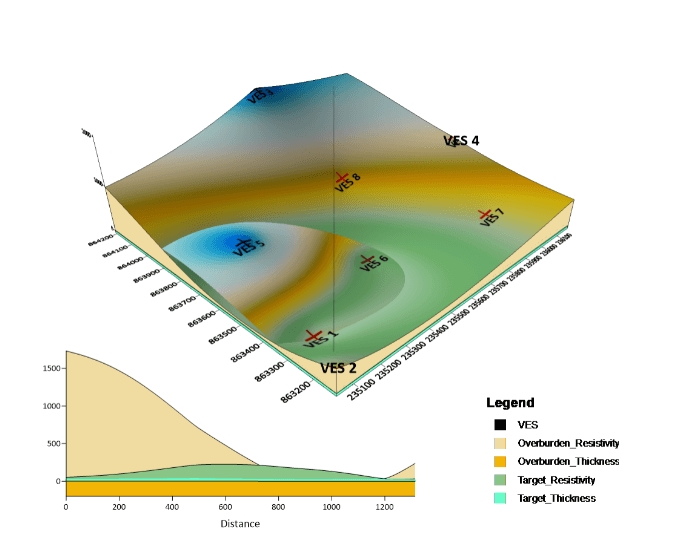
The image above represents an overlay of all 4 characteristics illustrated as a 3D surface model and a Profile map illustrating how they interact with each other.
CONCLUSION
In conclusion, overburden resistivity, overburden thickness, target thickness, and target resistivity are all important factors in mineral exploration and mining. They can provide valuable information about the characteristics of the rock and soil layers and the mineral or ore deposit being targeted. Understanding these factors and their impact on the mining process is crucial for the success of any mineral exploration project.

























































































